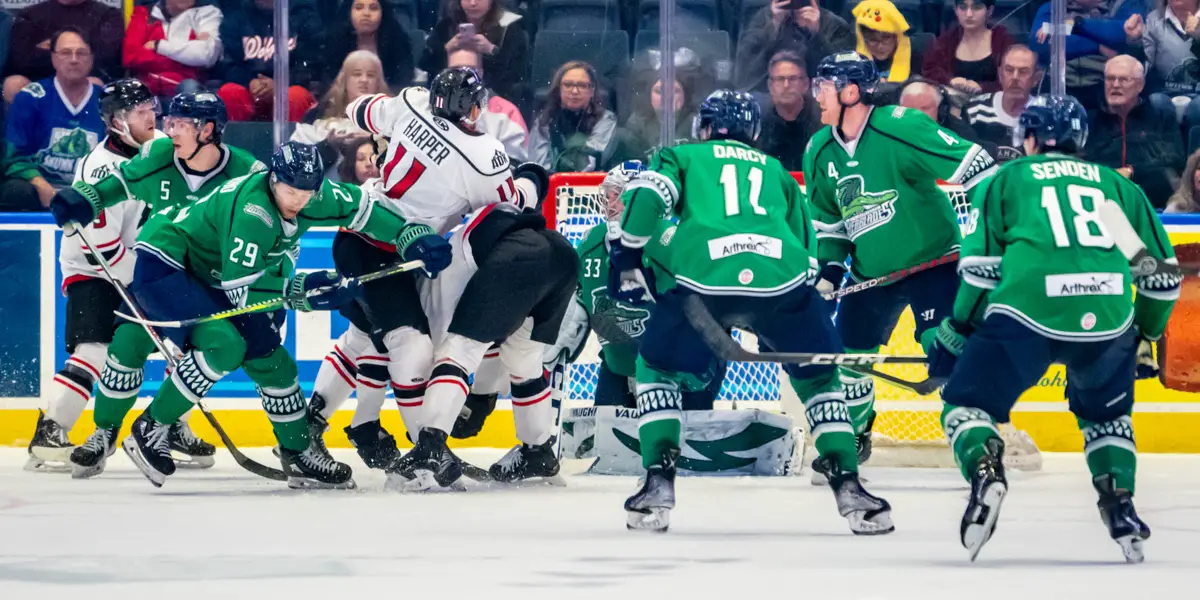
The first two games of the Eastern Conference Finals between the Adirondack Thunder and Florida Everblades are in the books, with the games played on Friday and Saturday night in Glens Falls, N.Y. The series is tied 1-1, with the Everblades winning game one, 2-1, and the Thunder bouncing back for the win in game two, 2-0. Florida won the regular season matchups 4-1-1-0. Here are some takeaways from these two games.
Takeaway 1: Special Teams
Adirondack was 16th in the league on the power play with 19.5% and 5thon penalty kill with 82.4% effectiveness, whereas the Everblades were 13th with 20.3% and tied for 1st with 85.3%. Both teams have had great success on the penalty kill, surpassing their season average in that category. Florida has killed 50 of 58 chances for 86.2%, and the Thunder has killed 41 of 49 for 83.7%. On the opposite end of the spectrum, neither team has performed well with the man advantage in the postseason, with the Thunder scoring seven times on 67 power plays for 10.4% and the Everblades scoring three goals on 38 chances for 7.9%. Adirondack is 0-12 with the man advantage through the two games in this series, and Florida is 0-7. A question for the coaches is whether the strength of the opponent’s penalty kill is more effective at shutting down the power play unit or if the power play unit isn’t executing the strategy. The Thunder have had solid offensive zone time, but they have been unable to penetrate the Everblades’ defensive structure. The Thunder have also missed several high-quality shots on net, sending the puck high or wide. The Thunder have also given up at least one quality short-handed scoring chance for the Everblades each game, a trend that continues from their previous rounds. The Everblades power play units have also effectively set up their system in the offensive zone. The Everblades, however, continue to overpass and cycle, which increases the chances the puck will be turned over and cleared. They have also been unable to connect on cross-ice passes for shooting opportunities. The team that gets their power play scoring will have a huge advantage in the series.

Takeaway 2: Penalties
The Everblades have taken too many penalties, twelve, through the two games. Many of those penalties were either undisciplined or from being flat-footed or out of position. The holding, hooking, tripping, and interference penalties, five total, indicate a player being out of position or caught flat-footed and using their stick or body to slow the opponent down. The delay of game and cross-checking penalties, five, are often due to undisciplined or poor decision-making. The Everblades took two penalties in the last half of the third period in game one. They were up 2-1, and the Thunder pressed the attack to get the tying goal. Logan Lambdin’s cross-checking penalty at 17:52 gave the Thunder a six-on-four advantage as they pulled their goaltender for an extra attacker. In game two, the Everblades took three penalties in the third period, reducing their chances of scoring two goals to tie the game. Even though the Everblades have solid penalty kill units, they need to take fewer penalties for two reasons. First, a penalty stunts any momentum a team has, and if you are trying to hold a lead or score goals, penalties reduce your ability to sustain offensive pressure. Second, the number of chances that the Everblades are giving the Thunder power play units allows them opportunities to get their power play on track and on the scoreboard.

Takeaway 3: The Team That Scores First
Adirondack and Florida are the only teams left in the playoffs that are perfect when scoring first. The Thunder have won the seven games they’ve scored first, and the Everblades have won the eight games they’ve scored first. The Everblades won game one after scoring first, and the Thunder won game two with the first goal. The Thunder have won two games after giving up the first goal and the Everblades one. The ability of both teams to expand on their opening goal is evident and can be representative of which team will win each game as the series progresses. However, the perfect streak that both teams are on is rare and even rarer as the playoffs continue. The teams must find a way to secure a victory when they give up the first goal; the Thunder have lost six, and the Everblades four after giving up the first goal.
Takeaway 4: Goaltending
Everblades goaltender Cam Johnson is a two-time Kelly Cup Champion and Kelly Cup Playoffs MVP and won the ECHL Best GAA with 2.21. Johnson posted a better save percentage than his past two in the regular season and the playoffs, with 0.921 and 0.934, respectively. He posted a 0.942 save percentage through the first two games against the Thunder. Thunder goaltender Isaac Poulter is in his second year as a professional and is under contract by the New Jersey Devils. He spent most of this season with the Utica Comets in the AHL, posting a 0.911 save percentage and a 17-8-1 record. Poulter was 5-0-0 for the Thunder in the regular season, posting a 0.917 save percentage. He is 7-6 in the playoffs with a 0.946 save percentage. Poulter is leading the playoffs with his 0.946 save percentage and four shutouts. He is second in wins with seven, second in saves with 366, and first in losses with six. Johnson is third with a 0.934 save percentage, first in wins with nine, and first in saves with 383. Both goaltenders are playing at the top of their game, and goals will be at a premium for the opposing offenses. The team that consistently gets bodies in front of the goalie and gets shots through for rebounds will be more successful in scoring goals.

Takeaway 5: Strategies

Watching games one and two, it’s evident that both teams have very similar playing styles: solid, lock-down defense; fast transitions through the neutral zone; either skating the puck into the offensive zone or firing the puck deep; strong play along the boards; and getting bodies in front of the goalie. One key indicator of the success of the offensive strategy is the effectiveness of the team points leaders. Teams often key off their opponents’ scoring leaders, resulting in season leaders having a more challenging time getting on the scoresheet. The Thunder season leaders, however, have been successful in the playoffs. Tristan Ashbrook (seven goals and 14 points), Shane Harper (15 points), and Ryan Smith (eight goals) lead the team. The Everblades scoring leaders have been on the scoresheet less in the playoffs. Bobo Carpenter (five goals and eleven points) is leading the team; Joe Pendenza and Oliver Chau both started slow and are scoring in single digits. The Everblades’ defensemen scored eight goals of their 37 with Cole Moberg leading with four. The defense, however, has yet to be as effective in this series. The Everblades need more scoring from their team leaders and the defensive unit. Another indicator of strategy success is the difference between quality and non-quality shots. Teams want more high-quality shots as they often result in more goals. In game one, The Everblades had 19 quality shots out of 30 for a 63.3% rate, and the Thunder had nine out of 22 for 40.9%. These numbers are unusually high for a playoff game, considering the teams scored only three goals between them. This shows that both offenses were able to execute their offensive strategy. Game two was more reflective of a playoff game, with the Everblades getting off eleven of 41 quality shots for 26.8% and the Thunder ten of 30 for 33.3%. The Everblades should have seen more success, given the number of shots and quality shots in the game, but the play of netminder Poulter kept the puck out of the Thunder’s net. The team that can execute their team strategies, have a high number of quality shots, and have solid play by their netminder will win the series.

There are many intangibles that determine the outcome of a game, as the game isn’t based on statistics and trends. This series has all the makings of going the full seven with each game closely contested. The series resumes with three home games for the Everblades. Game three is on Wednesday at 7:30 pm.
Discover more from Inside The Rink
Subscribe to get the latest posts sent to your email.



